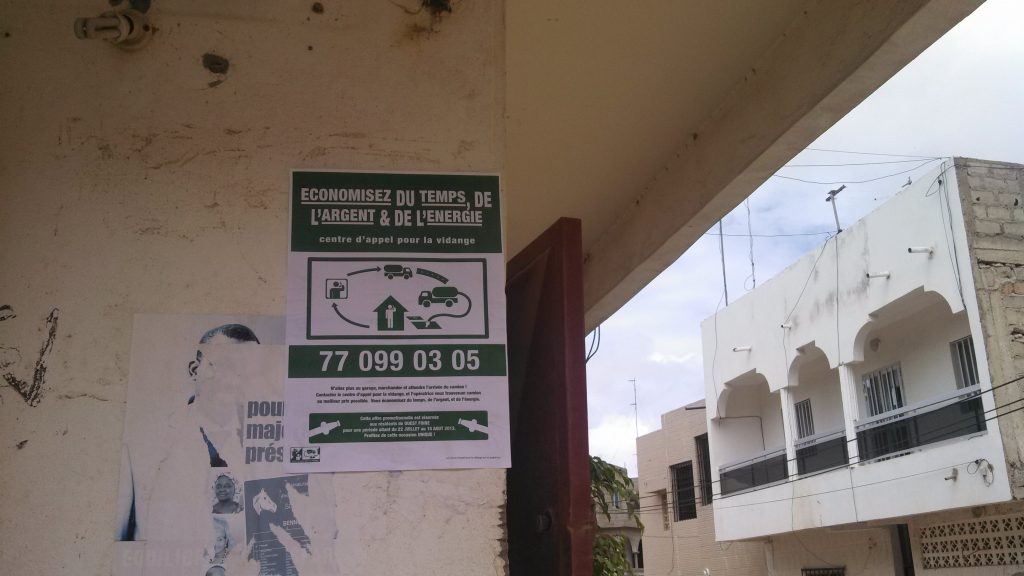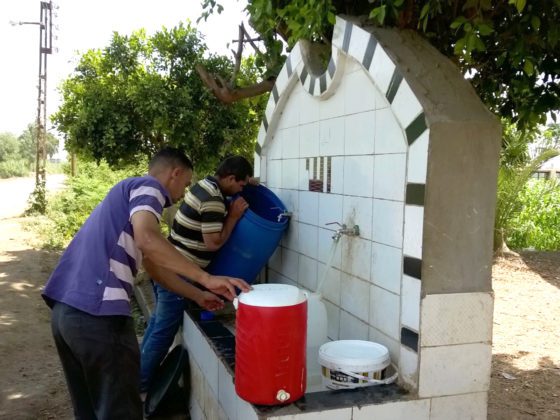Lack of access to sanitation affects 2.4 billion people as of 2016.[1] While many of those without access to sanitation are in rural areas, the problem is also pervasive in cities: 16.8% of the world’s urban population lacks access to basic sanitation.[2] Sanitation access has a strong effect on health and welfare: poor sanitation is the primary cause of 10% of all diarrheal disease and the primary cause of death for children under 5 in most developing countries.[3] Economists, civil engineers, and epidemiologists are increasingly interested in tackling these problems and understanding how to expand sanitation services to the poor. My research focuses on finding low-budget ways to make sanitation more affordable for families in poor urban environments.
In cities in which the sewer network does not extend to the poorer neighborhoods, households must build individual systems—septic systems or pit latrines. Household latrines and septic systems need to be emptied on average every 6 months and 3 years, respectively. A new dataset available from the Joint Monitoring Programme for Water Supply, Sanitation and Hygiene, a project of the World Health Organization (WHO) and the United Nations Children’s Fund (UNICEF), shows that the percentage of people who openly defecate or have access only to unimproved latrines is estimated to have decreased from 36.1% in 2000 to 23.8% in 2015.[4]
While rural areas have received most of the attention of sanitation programs from international organizations and NGOs, sanitation issues compound quickly in population-dense areas, making urban areas particularly susceptible to issues with waste management and disposal. Poorly constructed and unimproved latrines are common, and the inadequate disposal of fecal sludge contributes to important health problems in population-dense environments with little access to city public services. The management of latrine waste is important: households can choose either to hire a truck or to empty the latrine by hand. Manual emptying is less expensive, but imposes large costs on neighbors as the waste is commonly disposed of in the road in front of the household, causing the community to deal with the smell and health impacts for weeks until the sludge dries.
Why is sanitation such a problem in developing countries? We expect well-functioning markets to set efficient prices and quantities for goods and services, but sanitation is an example of a market with substantial market failures. There are externalities: for example, my use of improved sanitation strongly affects my neighbor, and I probably do not adequately take that into account when I decide whether to purchase improved services. There is also market power: functioning as a sanitation supplier requires investing large amounts for equipment, but this keeps many people out of the market, so suppliers are able to maintain higher prices by coordinating. Both of these market failures lead to lower-than-optimal quantities of sanitation being purchased.
We typically expect government to intervene to improve on the market outcome in cases with such substantial market failures. Governments in developed countries do often provide the services themselves or through a regulated monopoly. A new dataset, available at ib-net.org,[5] provides information on tariff rates and coverage for both water and sanitation services across the world.
In contrast, many developing countries do not have publicly provided sanitation services like sewer networks, particularly in poor and quickly expanding neighborhoods. This leaves many households at the mercy of a fragmented market, in which service providers and households ignore the substantial health benefits provided by improved services for third-party households. The sixth Sustainable Development Goal[6] targets universal coverage of affordable and safe drinking water and adequate sanitation by 2030, but many countries remain far from achieving that goal.
How Can Markets Help?
In a group of randomized controlled trials in West Africa, we are studying the effects of centralizing sanitation markets by intermediating between demand and supply through a call center. Our goal is to instigate competition in the market by generating demand for services through the call center and then allowing suppliers to bid for jobs through the same center. We tested several methods of intermediation, adapting the platform to the specific features of the market in Accra, the capital of Ghana; Ouagadougou, the capital of Burkina Faso; and Dakar, the capital of Senegal.
In Dakar, when we were first planning an intervention, I asked a trucker how he decided what prices to charge. He answered that the association met in a room and decided what prices households in different neighborhoods could afford to pay. This is clear cartel behavior, which raises prices and leads to low quantities being purchased. To increase competition, we ran just-in-time procurement auctions for sewage management services—each time a household called, the call center operator would send out a “call for bids” by SMS messages to 8–15 desludging truck managers. The trucks had one hour to bid, and at the end of the hour the lowest bid was selected; the trucker with the lowest bid was connected to the household via SMS message; and they would coordinate together to schedule the job. Preliminary results from the two years in which we ran the center suggest that prices came down by about 7%, over 5,000 completed auctions. The government scaled up the call center across Dakar, and it is now being managed by a private operator. We are working with the private operator to identify business models that allow the center to generate enough revenue to cover the costs of operating the call center while continuing to reduce prices in the market and encouraging households to switch to improved services.
When we sent enumerators to the field in Accra, the truckers were skeptical, having had a difficult relationship with the government, which was pushing them out of their parking areas and fining them for minor traffic offenses. One trucker threatened to release the sewage in his truck on our surveyor unless the surveyor left the garage area (the surveyor left). We needed a “lighter touch” model in Accra. In order to avoid conflict with the truckers, our model simply passed calls through to suppliers so that households and operators could negotiate directly. This was better adapted to the situation in Accra, in which the desludging operators were more suspicious of the call center, worried that they might bid too low on a given job, and wanted to interact with customers directly. The intervention still increased competition by making it easier for households to quickly negotiate with many operators.
Finally, we ran monthly auctions in Ouagadougou, and truckers coordinated on high prices, very close to market rates, for over a year. Frustrated that the auctions were not instigating competition, we tested whether competition could be improved through structured negotiations in which desludgers were directly asked to compete on specific jobs. Early analysis suggests that these negotiations led to substantially lower prices than the auctions—in some neighborhoods prices decreased by 33%.
In Summary…
Poor sanitation is a problem in developing countries, and while it is gaining attention, there is substantial work to do in ensuring universal access. In the absence of government provision of sanitation services, making the market for sanitation services more competitive can decrease prices and thereby increase the use of sanitation services. We tested three models of intermediation with the goal of increasing the power of the consumer and instigating increased competition among desludgers. While we are still working on analysis, our preliminary results suggest that these intermediation mechanisms help to increase competition and reduce prices in the market.
Molly Lipscomb is Associate Professor at the Batten School of Leadership and Public Policy at the University of Virginia. Her research focuses primarily on environmental issues in developing countries and adaptation to lack of centralized health and sanitation services.

Call Center Promotion Flyer, photo provided by Molly Lipscomb

Operators of the Call Center, photo provided by Molly Lipscomb
[1] Report of the Secretary-General, United Nations, “Progress Towards the Sustainable Development Goals,” July 24–27, 2016, E/2016/75 (accessed Oct. 1, 2018).
[2] WHO/UNICEF Joint Monitoring Programme for Water Supply, Sanitation and Hygiene, https://washdata.org (accessed Oct. 1, 2018).
[3] Duncan Mara, Jon Lane, Beth Scott, and David Trouba, “Sanitation and Health,” PLoS Medicine 7, no. 11 (Nov. 16, 2010), https://doi.org/10.1371/journal.pmed.1000363 (accessed Oct. 1, 2018).
[5] International Benchmarking Network for Water and Sanitation Utilities, https://www.ib-net.org/ (accessed Oct. 1, 2018).
[6] United Nations, “Goal 6: Ensure Access to Water and Sanitation for All,” Sustainable Development Goals, https://www.un.org/sustainabledevelopment/water-and-sanitation/ (accessed Oct. 1, 2018).





